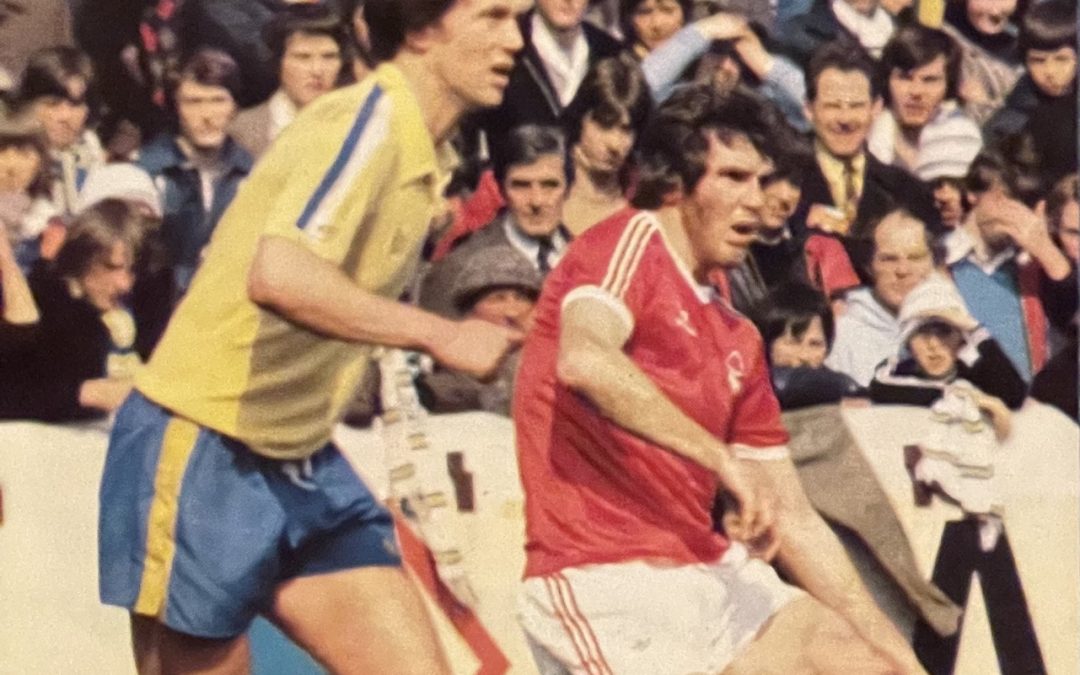TRAVELLIN’ MAN – The Peter Withe story (part one)
BY Vince Cooper
IT was a long and often winding road to the top for Peter Withe, but when he got there, he certainly made his mark, more than once.
There must have been times when accolades such as England caps, First Division titles and European Cup winners medals seemed a long way off but a combination of top-class ability, a strong work ethic and a never-give-up approach saw all eventually achieved.
Born in Liverpool in 1951, Peter’s first professional club was Southport who he joined in 1970 with former Everton defender Alex Parker the manager who signed him.. But after a mere three appearances for the Haig Avenue club he was released when Jimmy Meadows replaced Parker at the helm.
The next stop was Deepdale but a solitary appearance on trial for the reserves saw him let go again and he then joined Barrow where again the stay was brief. After playing in the 1-0 New Years Day defeat to his former club Southport, Withe was let go and it seemed that there was little future for him in English football.
South Africa-bound
At just 20-years-old and with his career in England clearly at a standstill, Withe decided to try his luck overseas so, along with wife Kathy he took off for South Africa. There, after a brief spell with Port Elizabeth City he joined Pretoria team Arcadia Shepherds. It was here that he finally got some meaningful playing time, and some goals on his resume, 26 matches seeing him find the net 16 times.
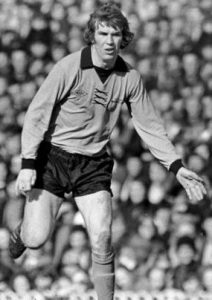
Wolves days
Those performances in the South African capital brought Withe to the attention of Wolverhampton Wanderers boss Bill McGarry. Although he spent a couple of seasons at Molineux his role was basically as understudy to then-first choices Derek Dougan and John Richards although he would surely have learned much from those two high-class front men.
After making 17 starts over those two campaigns, and finding the net three times, Withe was back to his globetrotting ways.
NASL – The Wizard of Nod
Former Aston Villa star and Welsh international Vic Crowe was coach of the Portland Timbers, one of five NASL expansion franchises for the 1975 season. He filled the new team with British imports with no fewer than 14 making the trek across the Atlantic. Withe had been offered the chance to return to South Africa but he decided instead to follow the U. S. path, joining Portland on loan from Wolves.
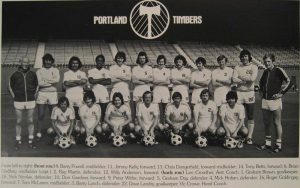
Portland Timbers 1975 with Peter wearing number nine.
1975 was a huge season for the NASL. The New York Cosmos had seemed set to sign George Best from Manchester United (The Northern Irishman even attended a press conference saying of his move: “As far as I’m concerned there will be no problem”) but the move fell through and instead they doubled down, bringing Pele in on a three-year $4.7m deal. Elsewhere, the likes of Eusebio, Mike England and Peter Bonetti all signed up and the sport finally seemed to be taking off.
Withe enjoyed a hugely successful time, as did his new team. Portland romped home in the Western Division, winning it by nine points from the Seattle Sounders and finishing with the best record throughout the league’s four Divisions. They then saw off the Sounders in the first round of the playoffs, winning 2-1 in front of 31,523 fans before overcoming the St Louis Stars by a single, Withe goal in the semi final, this time with 33,503 in attendance.
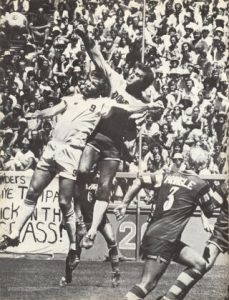
Peter in action for Portland Timbers
Those results sent the Timbers through to play in the Soccer Bowl where, fielding nine Englishmen, a Scot and a Welshman, they lost 2-0 to another expansion team, the Tampa Bay Rowdies who were skippered by former Chelsea man John Boyle and had Clyde Best, formerly of West Ham United, scoring one of the goals.
Withe’s goal against St Louis was his 16th of the 22-game season and he finished joint-third in the top-scorer lists and level with Gordon Hill who would join Manchester United from Millwall shortly after returning to England and go on to win six caps for England.
Those exploits earned him a place in the All Star Second Team and the nickname ‘The Wizard Of Nod’ among Timbers fans. They also brought him to the attention of English clubs and after returning home he made the relatively short move from Wolves to Birmingham City.
Just over a season at St Andrew’s finally saw a decent run of matches in English football.

In Birmingham colours
Lining up as one of a front three alongside Bob Hatton and Trevor Francis, Withe made 36 appearances and scored nine times as City finished 19th, one place above his former club Wolves. He also grabbed the only goal in Birmingham City’s centenary match against Celtic.
After playing three times for City in the early part of the 1976-77 season, Withe, with Kenny Burns now threatening his first team place, was on the move again, this time dropping down a division.
Nottingham Forest, with Brian Clough and Peter Taylor at the helm, bid around £44,000 for the front man which City, who had just signed Garry Jones and John Connolly from Everton, eventually accepted.
Withe wanted some time to think over the move although after four hours of talks with Taylor he said: “I am very impressed with the set-up at Forest even though they are a Second Division club.
“I would not be keen to step out of the First Division unless I was joining an ambitious club and that’s what Forest appear to be”.
After some haggling over a loyalty payment that the player felt he was due from City, Withe signed in time to make his debut – wearing borrowed boots – in Forest’s reserve team win over Wolves (Tony Woodcock also played before departing for a loan stint at Doncaster Rovers having previously spent a month at Lincoln City).
Peter’s first-team debut came 72 hours after his reserve bow on September 25 1976 against Carlisle United and it was a dream start. After falling behind early on Forest simply overwhelmed their opponents, scoring five times without reply. Withe won a penalty (which was missed), scored the last goal of the five and led the front line superbly.
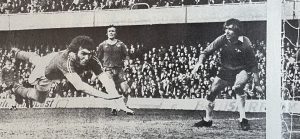
A diving header attempt against Chelsea
After the capture of Withe, Forest snapped up ex-Liverpool man Larry Lloyd from Coventry City. But it was the return of Woodcock and his pairing with the new centre-forward that proved the catalyst for Forest’s promotion push
With mercurial winger John Robertson providing the ammunition, Withe netted 16 times in 32 league matches and Woodcock added 11 as Forest finished third in the division behind Wolves and Chelsea to secure a return to the top flight.
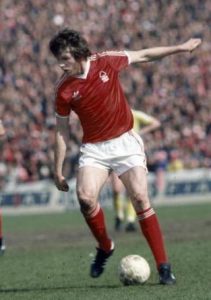
On the ball for Forest
There was also silverware at the City Ground courtesy of an Anglo-Scottish Cup win. Victories over Kilmarnock and Ayr United resulted in a final encounter with Leyton Orient which saw Clough and Taylor’s team emerge as 5-1 aggregate winners after the two legs.
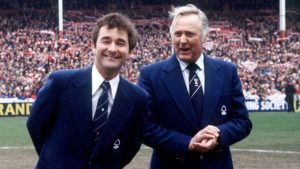
The Forest management team knew they needed to beef up their squad in order to become contenders in the top flight. Many of the components were already in place with the likes of Robertson, Ian Bowyer and John McGovern established whilst Woodcock, Martin O’Neill and Viv Anderson were just starting out on what would become great careers. But the management duo knew more would be needed.
Kenny Burns had begun his career as a centre-half but, having failed to make the grade at Rangers he switched to centre-forward at Birmingham when City sold Bob Latchford to Everton.
Having initially had a bid for the Scot turned down just before the previous season’s transfer window closed, Clough made an offer of £150,000 a week before the players reported for pre-season training and it was accepted by City although they had to wait for a week before completing the deal as Burns was on holiday.
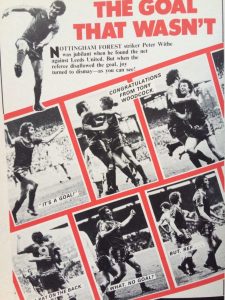
Goal? No goal. Peter sees his effort against Leeds United disallowed
Withe might have seen the new arrival as a threat to his place in the team again but Clough and Taylor quickly restored Burns to his original centre-half role and he would go on to have a fine season crowned by receiving the Footballer of the Year award.
The management team waited until after the season got underway before making further additions to their squad but the two men signed in September proved critical to the team’s success.
In August, Clough began his efforts to sign England international goalkeeper Peter Shilton whose team Stoke City had swapped places with Forest, being relegated to the Second Division at the end of the previous campaign.
Having initially bid £250,000 for his target, Clough raised his offer to £270,000 which the Potteries club accepted. Shilton demonstrated his eagerness to complete the move by forgoing a loyalty bonus due from from his former employers and also accepting a drop in wages.
The capture of Shilton made England Under-21 man John Middleton surplus to requirements and the club then used the goalkeeper’s six-figure valuation to add the final piece of their jigsaw.
Clough and Taylor had previously worked with Archie Gemmill at Derby County and, after a long pursuit that went on throughout the summer they finally added a third former Rams player with the Scot joining McGovern and John O’Hare at the City Ground.
The fee for Gemmill was £25,000 plus the £150,000-rated Middleton and Forest, already challenging near the top of the table by the time of the double swoop were further boosted.
Withe scored five times in his team’s first eight games but his performance on October 4 took both him and the club to a new level.
Against Bobby Robson’s talented Ipswich Town team, Forest initially struggled to break down an obdurate defence with Allan Hunter and Kevin Beattie at it’s heart. But Withe headed home a Robertson cross just before the interval to break the deadlock.
The second period saw Withe find the net three more times to give his team a 4-0 win. The goals sent the forward to the head of the scoring charts.
In fact Withe almost added a fifth but he had to settle for equalling Enoch ‘Knocker’ Reid’s Forest record of four goals in a First Division match set 70 years before.
Clough joked afterwards that he had considered substituting his centre-forward after his fourth strike saying; “I scored five against Brighton once and I didn’t fancy living with him if he’d matched that”.
The victory over Robson’s side sent Forest to the top of the table and from then on they never relinquished their spot at the pinnacle, finishing the season seven points clear of defending champions Liverpool.

Champions
In the League Cup, the City Ground men had to do battle without the cup-tied Shilton between the posts and with Middleton gone, it was left to 18-year novice Chris Woods to take over between the sticks.
In their run to the final it didn’t really matter who was in goal as Forest scored 23 times in six matches (Withe getting five of them). The showdown with Liverpool was a different story but Woods kept a pair of clean sheets, first in a goalless draw at Wembley which their opponents dominated.
Then in the 1-0 replay victory at Old Trafford, Forest, with five reserves on duty as in the first match due to injuries and the aforementioned cup-tied Shilton, defied the Anfield men again and emerged as 1-0 winners thanks to a controversial John Robertson penalty after John O’Hare brought down on the edge of the area.
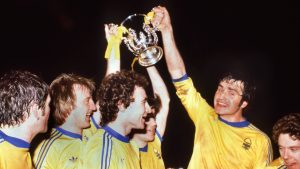
League Cup winners
The seven League Cup matches were the only times Woods played for Forest. After spending another season as Shilton’s back-up it became clear he wasn’t going to dislodge the England number one and he was sold to QPR for £250,000 . Woods would go on to play for Norwich City, Rangers and Sheffield Wednesday, winning 43 England caps himself.
Meanwhile, Withe finished the season with an impressive 19 goals in all competitions and although he was somewhat surprisingly overlooked by England, Division One and Football League Cup winners medals were plenty of reward for the completion of that long road to the top.
With his place at the head of the champion’s attack looking assured and Europe beckoning surely the best seemed yet to come. It did arrive, along with national team recognition, but at another location as we’ll cover in part two of the Peter Withe story.

